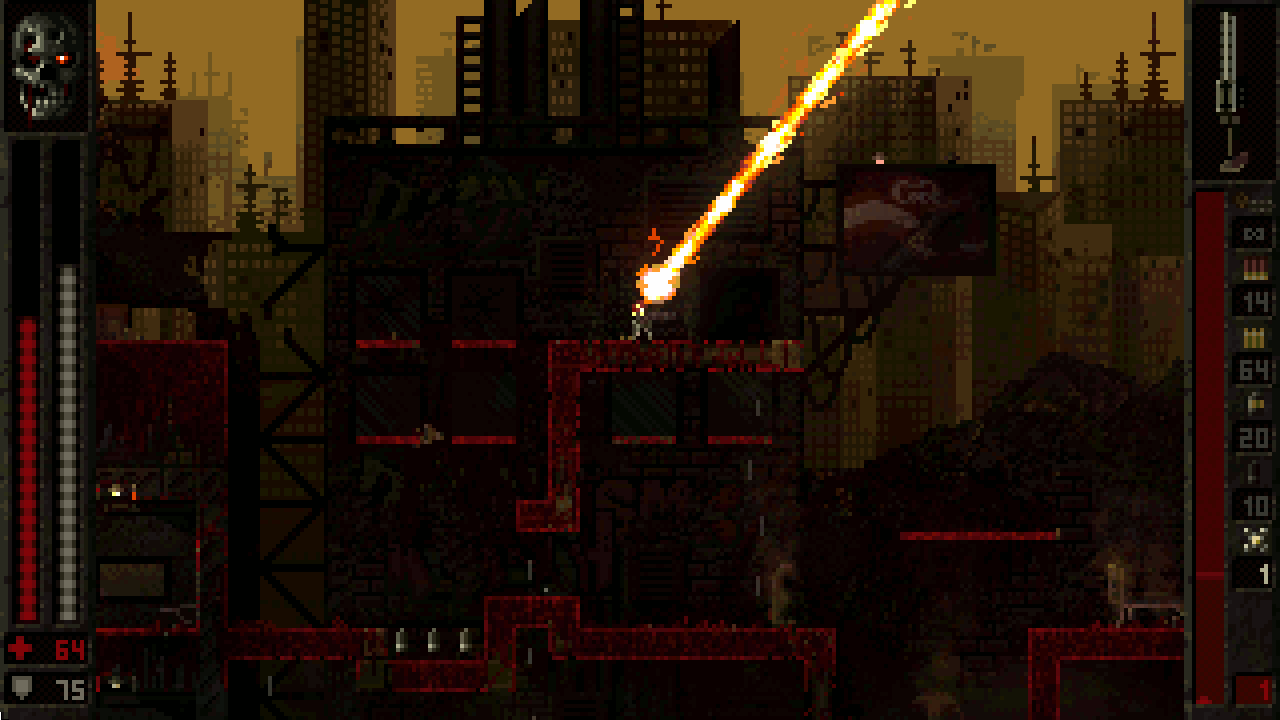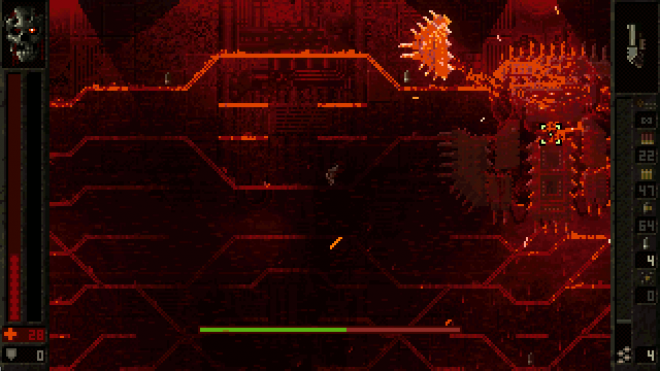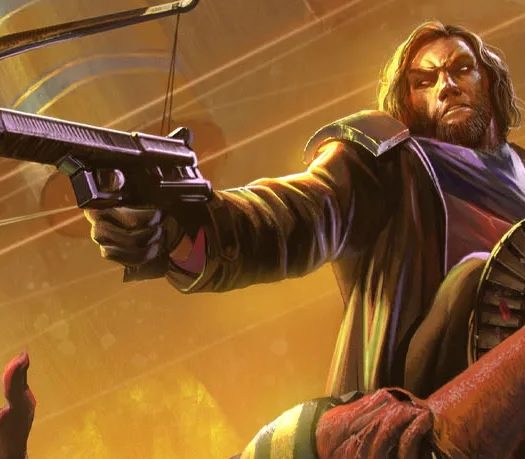Butcher takes its inspiration from seminal genre-defining first-person shooter Doom and may be the only game that wasn’t a first-person shooter to make that claim. Instead, Butcher looks at everything Doom has to offer that isn’t its perspective – the brutality, the gore and the lightning fast combat. This 2D twin-stick shooter does a lot to emulate its inspiration, right down to those old transitions that look like your screen is melting. If the fundamental ideas of Doom are enough to get you excited, then Butcher may be worth looking into.
Here’s what I liked:
Run and gun – The main gameplay loop is incredibly satisfying. Movement is fast and responsive; run with the left stick, jump with the left trigger, drop down platforms by pressing down. It’s simple but incredibly fluid, and perfectly complements the game’s true bread and butter: shooting. You aim with the right stick and shoot with the right trigger, familiar territory for twin-stick shooters. There’s a lock-on whenever you’re pointing towards an enemy, which really helps the flow of combat so you can focus more on staying alive than perfect aiming. The game’s small selection of guns are perfectly tuned; from the starting shotgun to the ultra-powerful railgun, every pull of the trigger feels crunchy and impactful. The effect on enemies only fuels the power trip; they fly back, explode and/or spill their guts everywhere. After a successful encounter, the level will literally be dripping with blood, capping off a thrilling combat trial with a gruesome look at your accomplishments.
Just hard enough – The game’s slogan, which appears on the title screen, is “The easiest mode is hard.” That’s a bit of a misnomer; there is an easier casual mode, but hard is the default difficulty. Every mode follows one principal rule: you only have one life to finish the level. If that sounds hard to you, don’t worry; it’s not nearly as bad as it seems. On standard “hard” difficulty you’re much more resilient than the average grunt, and there’s plenty of health and ammo pickups. Death can come swiftly, but only if you’re unprepared. As long as you shoot first and keep moving, finishing a level will only take a few tries. Levels are well-designed, incredibly varied, and just long enough so that replaying them repeatedly never feels like a slog.
Level variety – On the topic of level design, Butcher nails it. There’s a great variety of challenges, from traditional levels to horde modes to big setpieces where you run from lava flows. The game features five worlds, all of which look distinct and have their own unique quirks. Jungle levels have a big cat that attacks anything that moves; city levels have destructible walls, and so on. You really never know what you’re going to get; the game keeps you on your toes, and you blast through a stream of new and interesting ideas. With only 20 levels, it’s great that every one feels like the cream of the crop.
Here’s what I didn’t like:
The final boss – The entire game builds up to its only boss battle, and boy is it a doozy. Remember all the times you died before this point? Get ready to triple that number. The boss is so bizarre it’s beyond words, but the simplest way to describe is that it’s a giant segmented square covered in spikes. It takes up half the screen, floats above the play field, moves faster than you and can shoot its segments all the way across the battlefield. The level is scattered with health pickups, but they’re largely pointless because, unless it just barely grazes you, touching it is instant death. It’s just so fast and massive it’s impossible to avoid, and that’s before it decides to throw giant saws at you. The level design here doesn’t help; beyond being too constricting for the size of your foe, the layout really messes with you. The room has many layers of floors and ramps that make traversing the room as simple as possible. The problem is, all the floors are uneven due to the ramps, so the natural instinct to run away from the thing coming towards you may inadvertently cause you to run up or down into less obvious hazards. It’s an infuriating test of patience that lies in stark contrast to the rest of the game.
Demon spawn – While there are a variety of enemy types in the game, there is only one true way of categorizing them. Either they are present at the start of a level, or they warp in later. The former are fine; the latter are a problem. Before new enemies appear there is a small electrical cloud where they’ll show up and gives a little zap sound effect, which happens so fast it’s barely a warning. It’s common to think you cleared a room, only to have a surprise ambush drain your health almost instantly. There are a few other instances of sickly surprises that will kill anyone who hasn’t seen it before, but these spawns are the most frequent. Moments like this are cheap and unfair, encouraging hesitation and/or rote memorization in a game that largely supports running headfirst into danger guns a-blazing.
That’s it? – Butcher has 20 levels spread across its five worlds, not including the final boss and a (largely unnecessary) hub world. On a deathless run, the longest levels are no longer than a minute or two; a flawless run can easily take under half an hour. My inexperienced first run took almost three hours, almost a third of that on the last boss alone. Sure, it’s fine for a game to be short, but this one leaves you wanting more in a bad way. The content is fantastic, but when you take a closer look, there’s just so little of it. The game’s difficulty hides how little is actually in the game, and since they game’s so good, it just feels like there’s a whole lot of untapped potential. The game’s really meant for someone who’ll play it over and over, practicing and building to quicker and/or more difficult runs (both of which accomplishments are encouraged by achievements).
Wrap-up:
Butcher perfectly captures the feeling of being in a gunfight – it’s brutal, it’s bloody, and it’s over before you know it. Due to being brutal in both gameplay and aesthetic, not to mention a few major hang-ups, this isn’t a game that’s easy to recommend to everyone. That’s too bad though because when it’s good, it’s bloody brilliant. If you don’t mind getting some blood on your hands (and the floor, and the ceiling, and your face), then prepare to meet your doom.
Score: Reader’s Choice
Butcher was developed by Transhuman Design and published on Xbox One by Crunching Koalas. It was released May 10, 2017, for $9.99. A copy was provided for review purposes.






